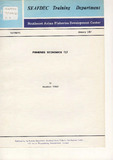Workshop to Support Implementation of National Regulation Regulation on Freezing Trawl Fisheries
Description
The project “Strategies for trawl fisheries bycatch management” (REBYC-II CTI) was conceived based on the successes of the 2002-2008 FAO/UNEP/GEF global project “Reduction of Environmental Impact from Tropical Shrimp Trawling through the Introduction of Bycatch Reduction Technologies and Change of Management”. The REBYC-II CTI project intends to focus on multispecies bottom trawling, where bycatch issues are amongst the most serious, with potentially significant effects on ecosystems and livelihoods. The Project aims to address these challenges by promoting sustainable fishing practices and improved trawl management. The REBYC-II CTI project was developed under the leadership of FAO (project implementing agency) in close collaboration with its partners: Southeast Asian Fisheries Development Center (SEAFDEC) and the governments of the participating countries Indonesia, Papua New Guinea, Philippines, Thailand and Viet Nam.
Trawl fisheries are among the most productive fisheries in the world. In Viet Nam, trawling is one of the most important fishing methods, with an estimated about 20,000 trawl vessels operating in the entire the country. The increase in demands on fish meal and other products from trawl fisheries in Viet Nam can be attributed to increase in fishing effort over the past years, including gear modification and speed of trawling, an expansion of the geographical range of fishing activities, and the retention of most animals caught (including shorter-lived, small, fast-recruiting species). The rapid increase in trawl fishing effort in Viet Nam can therefore lead to significant problems on sustainabbility of fisheries. This is because the increased landings that occurred as trawlers fished new grounds have led to the serial depletion of stocks. Attempts at regulating and controlling this trawl development have been universally weak and ineffective because of non-compliance, limited enforcement and fishers’ lack of awareness of regulations. As a result, catch rates and profits have declined, ecosystems have been altered, and conflicts between trawl fishers and other users of the resources, especially small-scale artisanal fishers, are a common occurrence. In addition, there has been unclear intention of management strategies to manage such impacting fisheries at the national level. Input and output control management and technical measures are common approaches to manage effective fisheries. These measures are partly being implemented in Viet Nam to manage trawlers but with significant limitations. Number of trawlers was controlled recently using a national legal document No 9443-BNN-TCTS dated on 18 October 2015 to freeze all trawlers in the entire the country. Some technical measures have also been applied legally such as fish size control, mesh size control and fishing closing areas/seasons.
The situation today in Viet Nam in trawl fisheries is that it catches enormous quantities and a great diversity of fish and shrimp to fulfil market demands, with very little discarding. The trawl sector provides very significant incomes and economic wellbeing for many local communities in the entire the country. It provides large number of jobs directly in the sector, and an even larger number in related industries such as fish meal factories, processing plants, transport, refrigeration, and supporting services. However, the expansion of trawl fisheries has reached a limit as there are no new, unexploited fishing grounds available. The contribution of trawl fisheries to fish production, occupations and income generation is counterbalanced by concerns about the sustainability of catches and ecosystem impacts. As a consequence, these fisheries require careful management underpinned by sound information and solid enforcement to support a transition to sustainable trawl fisheries management and practices. Recently, Viet Nam’s Government has adopted a new decision on freezing all trawl vessel in the entire country. However, this regulation is based on top-down control perspective with few consultations with stakeholders.
The main aim of this workshop was to provide chance for participants to discuss the negative and positive impacts of the implementation of the new freezing regulation on trawl fisheries in Viet Nam. Participants were mainly from local authorities who could provide feedback on their points of view on this regulation. In addition, participants could also recommend better solutions to effectively and sustainably manage trawl fisheries at the local and national level.
การอ้างอิง
Workshop to Support Implementation of National Regulation Regulation on Freezing Trawl Fisheries . (2016). Training Deoartment, Southeast Asian Fisheries Development Center.
คอลเลกชัน
- Country Activities [95]
รายการที่เกี่ยวข้อง
แสดงรายการที่เกี่ยวข้องตามชื่อผู้แต่งผู้สร้างและเรื่อง
-
Regional Guidelines for Responsible Fisheries in Southeast Asia Supplementary Guidelines on Co-Management Using Group User Rights,Fisheries Statistics, Indicators and Fisheries Refugia
SEAFDEC,ASSOCIATION OF SOUTHEAST ASIAN NATIONS (SEAFDEC, 2006-03)The Guidelines on “Use of Indicators for the Sustainable Development and Management of Capture Fisheries” which is to large extent related to fishery statistics, was developed to complement the programs on statistics, thus, ... -
Fisheries Economics (I)
Yamao, Masahiro (Training Department, Southeast Asian Fisheries Development Center, 1987-01)This textbook was initially prepared as part of the lectures on Fisheries Economics at SEAFDEC, in 1986. The contents are obviously not only introductory but also essential to our subject. In addition to my summarized ... -
SEAFDEC Seminar 2018: Fisheries and Marine Environment
Southeast Asian Fisheries Development Center, Training Department (Training Department, Southeast Asian Fisheries Development Center, 2018)Proceeding of SEAFDEC Seminar 2018: Fisheries and Marine Environment




